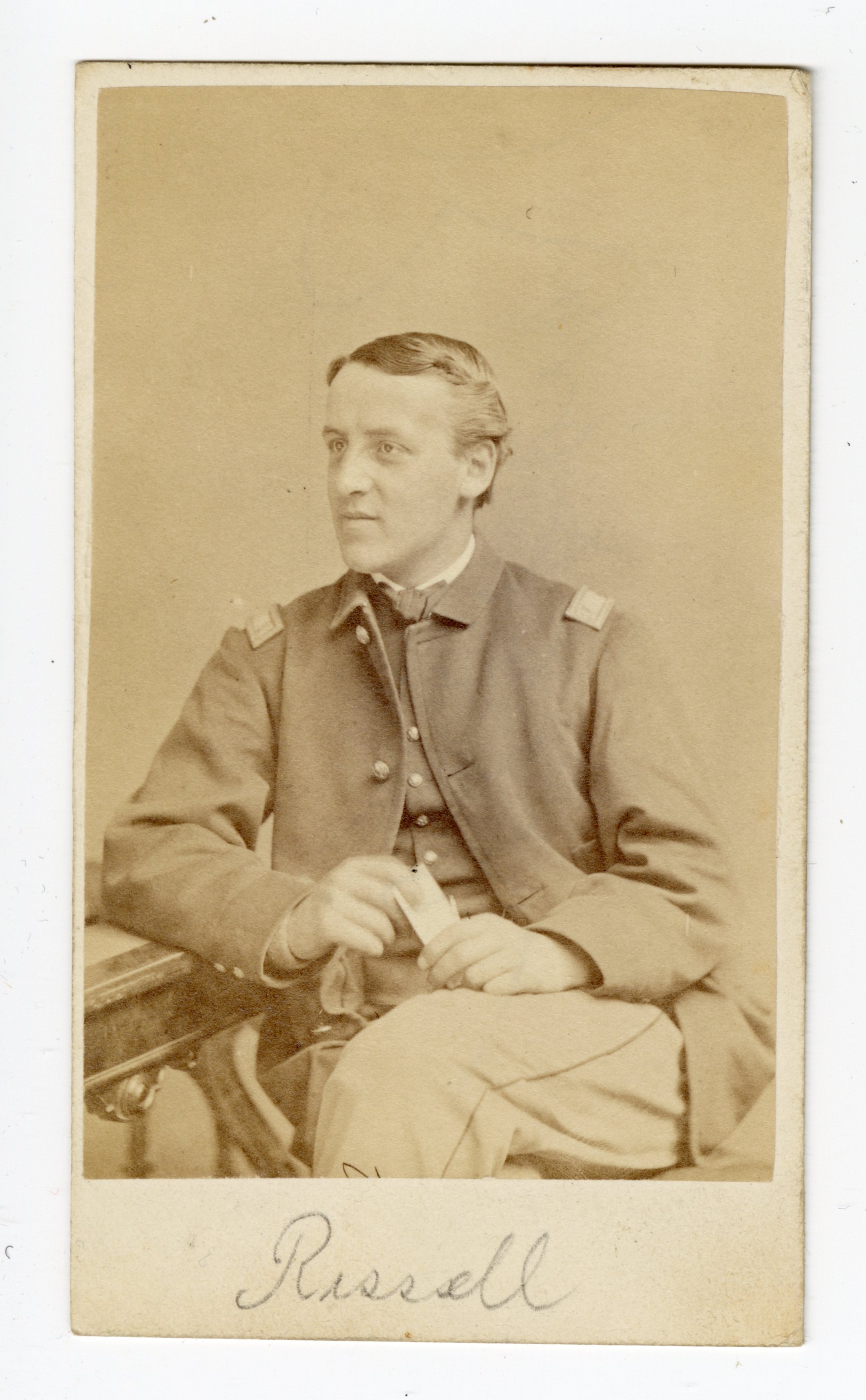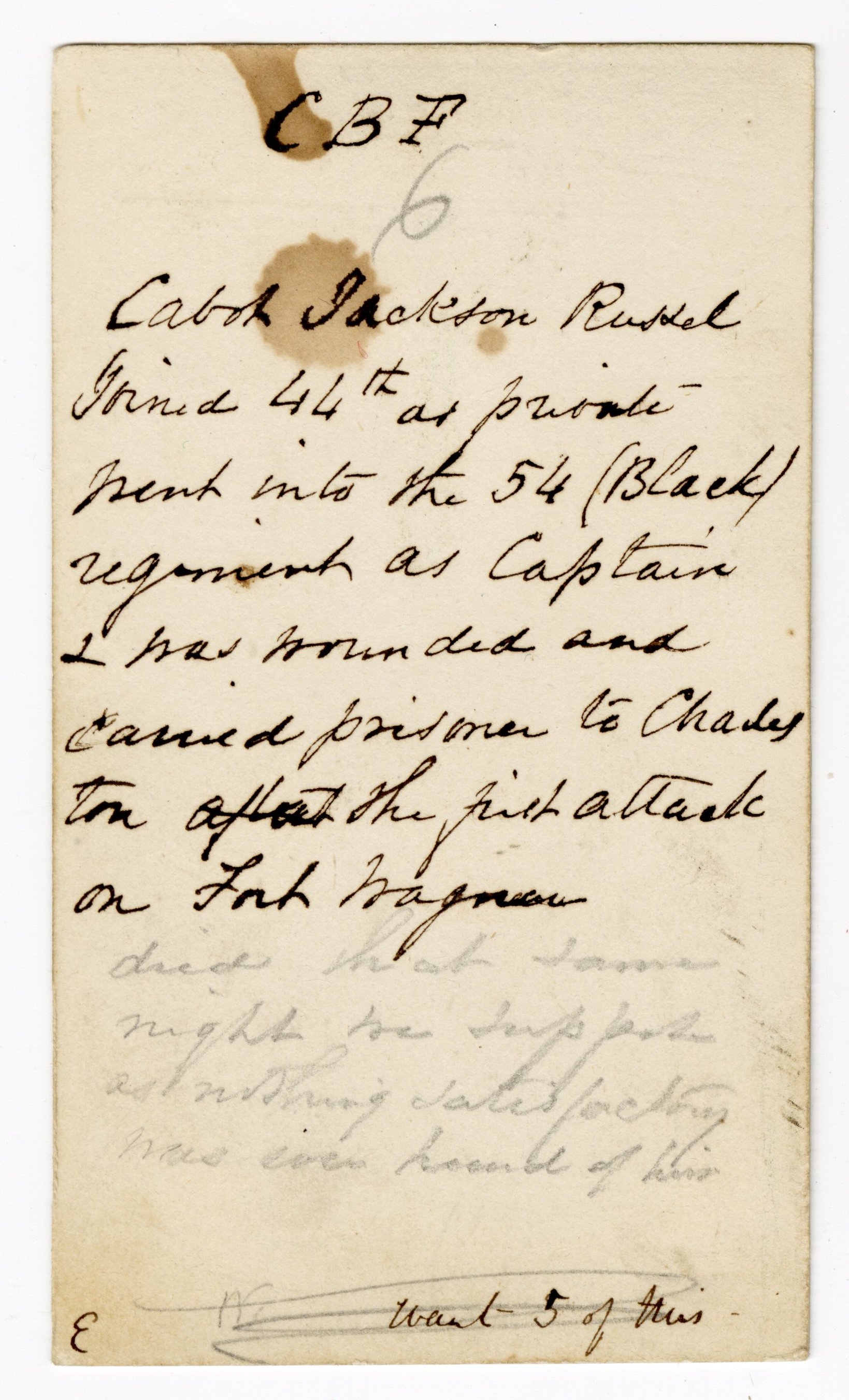54th Massachusetts Infantry - Killed at Fort Wagner
Item CDV-10892
Cabot J. Russell
Price: $1200.00
Description
“Following the Colors on James Island”By Scott Valentine
Young patriots enlisted in the Union army for a myriad of reasons.
But for one 16-year-old boy, the moment of decision came after he received word of the death of a cousin.
The letter bearing the tragic war news reached Cabot Jackson Russell faraway from the front lines at Fort Laramie in Dakota Territory (later Wyoming), where he was engaged in a peaceful pursuit—exploring the flora and fauna of the Northern Plains. He had gone there at the behest of his anxious father, William C. Russell, who feared that his teenaged son would run away and join the army. The father’s decision to send his son to safety was confirmed during the journey west. In a letter home, young Russell noted, “I don’t know about Jim or Charley. If anything has happened to either one of them I shall want to enlist.”
im and Charley Lowell were his cousins. They were, like Russell, Harvard boys of wealth and privilege. James Jackson Lowell left law school to become an officer in the 20th Massachusetts Infantry. Charles Russell Lowell took a leave from his career as a railroad executive and became a captain in the regular cavalry.
The letter that Russell received at Fort Laramie announced the mortal wounding of cousin Jim on June 30, 1862, at the Battle of Glendale, during the Peninsula Campaign.
He forwarded it to a friend, writing across its top, “Now I shall certainly go.”
And go he did. Russell signed on as a private in the 44th Massachusetts Infantry for a nine-month enlistment, and soon earned his sergeant’s stripes. He might have remained in the regiment for the full term, but a need for officers brought him home early. In late 1862 and early 1863, organization got underway for the African-American 54th Massachusetts Infantry. Bay State Gov. John A. Andrew requested that white soldiers currently serving in the 44th be made available to officer the new regiment and serve under its commander, Col. Robert Gould Shaw.
In March 1863, Russell was offered a commission as a first lieutenant in Company F. He accepted, likely motivated by the opportunity for advancement and by his father, a Cornell University professor and anti-slavery man in New York. Less than two months later, he received his captain’s bars and command of Company H. The regiment soon received orders for its deployment to the South Carolina coast.
Russell quickly proved himself a capable combat officer. On July 16, 1863, near Grimball’s Landing on James Island, S.C., his company formed part of a picket line surprised by approximately 1,400 rebels commanded by Brig. Gen. Alfred H. Colquitt. A small but fierce engagement ensued. Threatened by envelopment, Russell’s company fell back, with the enemy in pursuit. According to the regimental historian, “A mounted officer charged up to Russell, and cut twice at his head with his sword. Preston Williams of Company H caught the second sweep of the sword upon his bayonet and shot the Confederate through the neck, thus saving his captain’s life.”
Colquitt reported that the 54th had turned tail and ran. Other reports stated the picket line had held for about an hour. Either way, the precious minutes gained here by the 54th allowed a fellow regiment, the 10th Connecticut Infantry, to escape destruction by the Confederates. The stubborn resistance also allowed Brig. Gen. Alfred H. Terry to form the remaining companies of the 54th with the rest of his division. Terry’s men had barely taken up their position to face the Confederates when the picket line came into view. The regimental historian reported that the picket looked worse for wear, with “All bearing evidence of struggles with bush and brier, some of the wounded limping along unassisted, others helped by comrades. One poor fellow, with his right arm shattered, still carried his musket in his left hand. Captain Russell appeared in sight, assisting a sergeant, badly wounded.”
Minutes later, rebel artillery went into action against Terry’s line. Their aim was high. “It was a supreme moment,” recalled the historian of the 54th, “then under fire as a regiment for the first time. The sight of wounded comrades had been a trial; the screaming shot and shell flying overhead, cutting the branches of trees to the right, had a deadly sound. But the dark line stood stanch, holding the front at the most vital point. Not a man was out of place, as the officers could see while they stood in rear of the lines, observing their men.”
“He was alive during the night, and frequently called for water, but died before morning. We were not allowed to leave our posts, under penalty of being shot by the men behind us, so no one went to him.”
Union gunners replied. First a battery of Connecticut artillery opened up, followed by the massive booms from faraway Parrott guns operated by the navy. Meanwhile, Russell and the rest of the 54th waited for Colquitt to unleash his attack. It never came. Disorganized by the fire, the Confederate brigadier abandoned his plans and withdrew.
Though the action ended without a full-scale attack, the encounter cost the 54th. The regiment suffered 14 killed, 17 wounded and 12 captured in what became known as the Battle of Grimball’s Landing. Russell was singled out for his abilities and courage. Justly proud of his company, he observed, “My men did nobly.”
Russell and Company H had little time to rest on their newly won laurels. Less than 48 hours later, the 54th spearheaded a nighttime assault against the garrison of Fort Wagner.
Quincy A. Gillmore, the Union brigadier in command of the Department of the South, considered Fort Wagner one of the keys to the back door of his ultimate objective, Charleston. He made plans to take Wagner, and Col. Shaw volunteered the 54th to lead the attack at dusk on July 18, 1863.
Shaw, who had a presentment of his own death, inspired his men before the fight with words that referenced a future he would never know. He spoke with grim determination, the corners of his mouth twitching, according to the regiment’s historian. “Now I want you to prove yourselves men, and reminded them that the eyes of thousands would look upon the night’s work.”
Several minutes passed before Shaw commanded “Forward!” His men, 650 muskets strong, advanced in quick time across the seashore sand towards Fort Wagner. Rushing down the beach with Shaw was Russell, just three days shy of his 19th birthday.
The 54th rapidly advanced to the base of the fort, as blasts from Confederate guns inside lit up Wagner’s walls in the darkness. Momentary flashes illuminated gaps in the ranks, and the beachhead strewn with dead and wounded. Shaw and his men struggled up the ramparts towards the parapet. The shot and shell continued unabated as Shaw gained the rampart. “He stood there for a moment with uplifted sword, shouting, ‘Forward, Fifty-fourth!’ and then fell dead, shot through the heart, besides other wounds,” recounted the historian of the 54th.
Pvt. Thomas E. Burgess of Company I told a similar story. According to a reporter who interviewed him, Burgess “was close to Colonel Shaw; that he waved his sword and cried out, ‘Onward, boys!’ and, as he did so, fell. Burgess, fell, wounded, at the same time. In a minute or two, he tried to pull Colonel Shaw along, taking hold of his feet, which were near his own head, but there appeared to me no life in him.”
Russell also made it to the parapet and, like Shaw, crumpled to the ground in a hail of rebel lead. He fell near the base of a gun close to the left side of the curtain wall, a parapet connecting bastions or batteries in a line of entrenchments. A sergeant who climbed the parapet with Russell, Stephen A. Swails of Company F, later recalled that Russell had suffered wounds in the leg and breast. According to Swails, Capt. William H. Simpkins, who had served with Russell in the 44th, was nearby when Russell fell, and asked the desperately wounded officer if wanted to be carried back to safety. Russell declined the offer, but requested to lie straightened out. Simpkins called out to Swails to assist him. As Simpkins leaned over Russell’s head, a bullet tore through his body. Simpkins recoiled, clenched his hand to his chest and toppled across the prostrate Russell. Simpkins never spoke or moved again. Russell, still alert, asked Swails to change position so that he might not draw fire to the wounded men lying around them. Swails obeyed, and left Russell and the other wounded strewn along the parapet.
About this time the 54th fell back. The regiment had sustained heavy casualties, losing 42 percent of its rank and file, and a third of its officers, including Russell, who was reported missing and presumed dead. Overall federal losses totaled 1,500—the defenders of Fort Wagner, less than 200.
Word of Russell’s status soon reached his father, who set off from his residence in New York City for Charleston. He checked all of Charleston’s hospitals, and wandered the streets knocking on doors. He followed up on information provided by the local authorities and scoured Union camps to no avail.
Russell’s body was never recovered. It has been assumed that he was buried in the trench at the base of the curtain wall along with Shaw, Simpkins and the enlisted men killed in the assault.
But post-war accounts offered conflicting evidence.
An 1882 letter from Confederate Capt. H.W. Hendricks, who was present at Fort Wagner, claims that Shaw was the only officer buried with the enlisted men. An 1869 account of the battle by Maj. John W.M. Appleton of the 54th quotes a statement by a Confederate sailor who had volunteered with 79 other navy men to defend Fort Wagner. William H. Gladding was posted at the first gun to the right in the battery on the curtain wall. He recalled, “On the exterior slope of the rampart, a little to the left of Shaw’s body, Cabot J. Russel lay. He was alive during the night, and frequently called for water, but died before morning. We were not allowed to leave our posts, under penalty of being shot by the men behind us, so no one went to him.” Gladding continued, “The next morning I stood on the traverse, and saw Colonel Shaw, Captain Simpkins, and, I think, Russell, thrown into a pit with some of the colored men.”
Russell’s sword, engraved with his initials and regiment, turned up later in Savannah, Ga. According to a 1903 report in the National Tribune of Washington, D.C., the saber was returned to surviving members of the Russell family.
His memory lives on in the words of a brother officer. “From temperament and principle he was an enthusiast for freedom,” observed the adjutant of the 54th, Garth W. “Wilkie” James. “His sympathies grew with the enforcement of the negroes’ rights. He would gladly have devoted his life, if it had been protracted, to this cause. As it was, he gave it up in its very flower with a zeal, a courage, a disinterestedness unsurpassed even in the annals of the war. To his soldiers he said, ‘Do not touch me; move on, men! Follow your colors.’”
Source: Article from Military Images Magazine, September 3, 2016.


